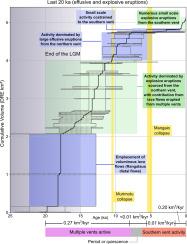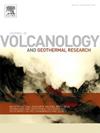新西兰奥特罗阿鲁阿佩胡火山冰川后的喷发活动:熔岩流量和喷发速率
IF 2.3
3区 地球科学
Q2 GEOSCIENCES, MULTIDISCIPLINARY
Journal of Volcanology and Geothermal Research
Pub Date : 2025-09-23
DOI:10.1016/j.jvolgeores.2025.108435
引用次数: 0
摘要
火山喷发造成的危害与喷发的频率和强度直接相关,了解过去事件的这些参数有助于评估与个别火山有关的未来危害。鲁阿佩胡火山是一座安山岩层状火山,在过去20年中产生了数十个熔岩流和熔岩单元,并在全新世早期和中期受到两次侧翼崩塌的影响。最近的研究已经显著改善了年轻(20 ka)熔岩流形成喷发的年代学,但这些事件的规模仍然很有限。在这项研究中,我们估计了鲁阿佩胡52个年轻熔岩流的体积,并将这些数据与所有可用的时间限制和已发表的火山碎屑喷发的体积和时间数据相结合,得出了鲁阿佩胡过去20年的详细的累积喷发体积曲线。末次盛冰期末期大量熔岩流进入后,喷发速率相对稳定在0.27 km3/kyr(致密岩石当量或DRE)左右,直至约7.4 ka。然后,活动停止了大约2kyr,之后活动恢复了,强度低于7.4 ka之前,并且仅来自南部的通风口。研究表明,鲁阿佩胡峰顶地区的两次全新世侧翼崩塌对管道系统和岩浆系统的影响不同;早全新世较大的崩塌迫使喷发方式向喷涌喷发转变,而中全新世较小的崩塌对火山活动没有显著影响。这项研究显示了强大的体积和时间分析在提供对层状火山演化的见解方面的重要性,特别是在分析其活动的时间变化的原因时。本文章由计算机程序翻译,如有差异,请以英文原文为准。

Postglacial effusive activity at Mt Ruapehu, Aotearoa New Zealand: Lava flow volumes and eruptive rate
Hazards posed by volcanic eruptions are directly related to the frequency and magnitude of eruptions, and understanding these parameters for past events helps to assess future hazards associated with individual volcanoes. Ruapehu (Aotearoa New Zealand) is an andesitic stratovolcano that produced several dozens of lava flows and tephra units during the last 20 kyr, and has been affected by two flank collapses during the Early and Middle Holocene. Recent studies have significantly improved the chronology of young (<20 ka) lava flow forming eruptions, but the magnitude of these events remain poorly constrained. In this study, we estimate the volume of 52 young lava flows at Ruapehu, and combine this data with a compilation of all available chronological constraints and published volumetric and chronological data of pyroclastic eruptions, to produce a detailed cumulative erupted volume curve for the last 20 kyr at Ruapehu. After the emplacement of large lava flows during the end of the Last Glacial Maximum (LGM), the eruptive rate remained relatively constant at around 0.27 km3/kyr (dense rock equivalent or DRE) until ca. 7.4 ka. Then, activity ceased for c. 2 kyr, after which it resumed less intensely than before 7.4 ka and from the southern vent only. Our data suggests that the two Holocene flank collapses that affected Ruapehu’s summit area have had different effects on the plumbing and magmatic system; the larger Early Holocene collapse forced a change in eruptive style towards effusive eruptions, while the smaller Mid-Holocene collapse did not have a significant impact on the volcanic activity. This study shows the importance of robust volumetric and chronological analyses in providing insights on the evolution of stratovolcanoes, and particularly when analysing the causes of the temporal variability of their activity.
求助全文
通过发布文献求助,成功后即可免费获取论文全文。
去求助
来源期刊
CiteScore
5.90
自引率
13.80%
发文量
183
审稿时长
19.7 weeks
期刊介绍:
An international research journal with focus on volcanic and geothermal processes and their impact on the environment and society.
Submission of papers covering the following aspects of volcanology and geothermal research are encouraged:
(1) Geological aspects of volcanic systems: volcano stratigraphy, structure and tectonic influence; eruptive history; evolution of volcanic landforms; eruption style and progress; dispersal patterns of lava and ash; analysis of real-time eruption observations.
(2) Geochemical and petrological aspects of volcanic rocks: magma genesis and evolution; crystallization; volatile compositions, solubility, and degassing; volcanic petrography and textural analysis.
(3) Hydrology, geochemistry and measurement of volcanic and hydrothermal fluids: volcanic gas emissions; fumaroles and springs; crater lakes; hydrothermal mineralization.
(4) Geophysical aspects of volcanic systems: physical properties of volcanic rocks and magmas; heat flow studies; volcano seismology, geodesy and remote sensing.
(5) Computational modeling and experimental simulation of magmatic and hydrothermal processes: eruption dynamics; magma transport and storage; plume dynamics and ash dispersal; lava flow dynamics; hydrothermal fluid flow; thermodynamics of aqueous fluids and melts.
(6) Volcano hazard and risk research: hazard zonation methodology, development of forecasting tools; assessment techniques for vulnerability and impact.

 求助内容:
求助内容: 应助结果提醒方式:
应助结果提醒方式:


